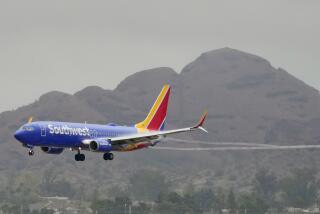Airport Bomb Detectors Not Working, Official Says
- Share via
WASHINGTON — New $1-million bomb-detection machines are not living up to their promise, delaying efforts to screen all baggage for explosives, the Transportation Department’s inspector general has found.
Meanwhile, airlines have hindered Federal Aviation Administration efforts to test how effective and reliable the devices are by not sending all of their checked luggage through the machines, said Alexis M. Stefani, deputy assistant inspector general for aviation.
“Without improvements in performance, explosives detection systems may not facilitate FAA’s goal to ultimately screen 100% of checked baggage,” Stefani told the House aviation subcommittee last week. “Based on our work, this goal will not be achievable in the near future.”
The $1-million machines are supposed to plug a gaping hole in the nation’s airline security system: the inability to detect plastic explosives, such as the device that blew up Pan Am Flight 103 over Lockerbie, Scotland, in December 1988. Conventional X-ray machines, effective in deterring hijackings, cannot detect plastic explosives.
Awaiting the detection machines, airlines this year began profiling passengers, using a series of criteria to determine which people should be singled out for further examination.
The federal government is spending $68 million to install the machines at airports around the country. But the machines are not working as well in airports as they did during preliminary tests, reporting more than twice as many false alarms as expected.
Furthermore, airlines aren’t using the machines to capacity. Though the equipment can screen up to 225 bags an hour, 10 of the 11 machines reviewed by the inspector general were given fewer than 200 bags a day.
On another safety issue, the inspector general reported that airlines had started to follow required security procedures for handling shipments, but air couriers still were not complying with the rules.
The Transportation Department had ordered another round of tests after a January report by the FAA and the inspector general found the airlines and couriers were ignoring the regulations.
The report found that security was so lax that 10 packages--each wrapped in plastic and loaded with 50 pounds of pesticide--slipped by airline personnel in Miami and weren’t discovered until one burst as it was being loaded onto a plane.
More to Read
Sign up for Essential California
The most important California stories and recommendations in your inbox every morning.
You may occasionally receive promotional content from the Los Angeles Times.










